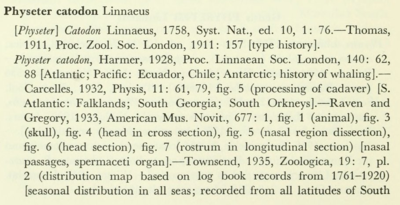- Chresonym
-
In biodiversity informatics, a chresonym refers to the cited use of a taxon name, usually a species name, within a publication. The term is derived from the Greek "chresis" meaning "a use"[1] and refers to published usage of a name.
The technical meaning of the related term "synonym" is for different names that refer to the same object or concept. As noted by Hobart and Rozella Smith,[1] systematists had been using "the term (synonymy) in another sense as well, namely in reference to all occurrences of any name or set of names (usually synonyms) in the literature." Such a "synonymy" could include multiple listings, one for each place the author found a name used, rather than a summarized list of different synonyms. The term "chresonym" was created to distinguish this second sense of the term "synonym."[1]
A name that correctly refers to a taxon is further termed an orthochresonym while one that is applied incorrectly for a given taxon may be termed a heterochresonym.[2][3]
Contents
Example (orthochresonymy)
Species names consist of a genus part and a species part to create a binomial name. Species names often also include a reference to the original publication of the name by including the author and sometimes the year of publication of the name. As an example, the sperm whale, Physeter catodon, was first described by Linnaeus in the 10th edition Systema Naturae published in 1758. Thus, the name may also be referenced as Physeter catodon Linnaeus 1758. That name was also used by Harmer in 1928 to refer to the species in the Proceedings of the Linnaean Society of London and of course, it has appeared in numerous other publications since then. Taxonomic catalogues, such as "Catalog of Living Whales" by Philip Hershkovitz,[4] may reference this usage with a Genus+species+authorship convention that may appear to indicate a new species (a homonym) when in fact it is referencing a particular usage of a species name (a chresonym). Hershkovitz, for examples refers to Physeter catodon Harmer 1928, which can cause confusion as this name+author combination really refers to the same name that Linnaeus first published in 1758.
Example (heterochresonymy)
Nepenthes rafflesiana, a species of pitcher plant, was described by William Jack in 1835.[5] The name Nepenthes rafflesiana as used by Hugh Low in 1848 is a heterochresonym. Cheek and Jebb (2001)[6] explain the situation thus:
Low, ... accidentally, or otherwise, had described what we know as N. rafflesiana as Nepenthes × hookeriana and vice versa in his book "Sarawak, its Inhabitants and Productions" (1848). Masters was the first author to note this in the Gardeners' Chronicle[7]..., where he gives the first full description and illustration of Nepenthes × hookeriana.
The description that Maxwell Tylden Masters provided in 1881 for the taxon that had previously been known to gardeners as Nepenthes hookeriana (an interchangeable form of the name for the hybrid Nepenthes × hookeriana) differs from Low's description. The International Code of Nomenclature for algae, fungi, and plants does not require that descriptions from so long ago include specification of a type specimen, and types can be chosen later to fit these old names. Since the descriptions differ, Low's and Masters' name have different types. Masters therefore created a later homonym, which, according to the rules of the code is illegitimate.
See also
References
- ^ a b c Smith, Hobart M & Rozella B Smith (1972). "Chresonymy ex Synonymy". Systematic Zoology 21: 445–445. doi:10.2307/2412440. ISSN 0039-7989.
- ^ Dubois, A. (2000). Synonymies and related lists in zoology: general proposals, with examples in herpetology. Dumerilia. 4(2): 33–98.
- ^ Dubois A (2010) Retroactive changes should be introduced in the Code only with great care: problems related to the spellings of nomina. Zootaxa 2426:1–42
- ^ Hershkovitz, Philip (1966). "Catalog of Living Whales". Bulletin of the United States National Museum 246: 1–259. ISSN 0096-2961. http://www.biodiversitylibrary.org/item/33227.
- ^ William Jackson Hooker, ed (1835). "Description of Malayan plants". Hookers Companion to the Botanical Magazine 1: 121–157, 219–224, 253–273. http://www.archive.org/details/companiontobota01hookgoog.
- ^ Cheek, M.R. & M.H.P. Jebb (2001). Nepenthaceae. Flora Malesiana. 15. National Herbarium of the Netherlands.
- ^ Maxwell Tylden Masters (1881). "New garden plants: Nepenthes hookeriana". The Gardeners' Chronicle: 812–813. http://www.biodiversitylibrary.org/item/84372.
Categories:
Wikimedia Foundation. 2010.

